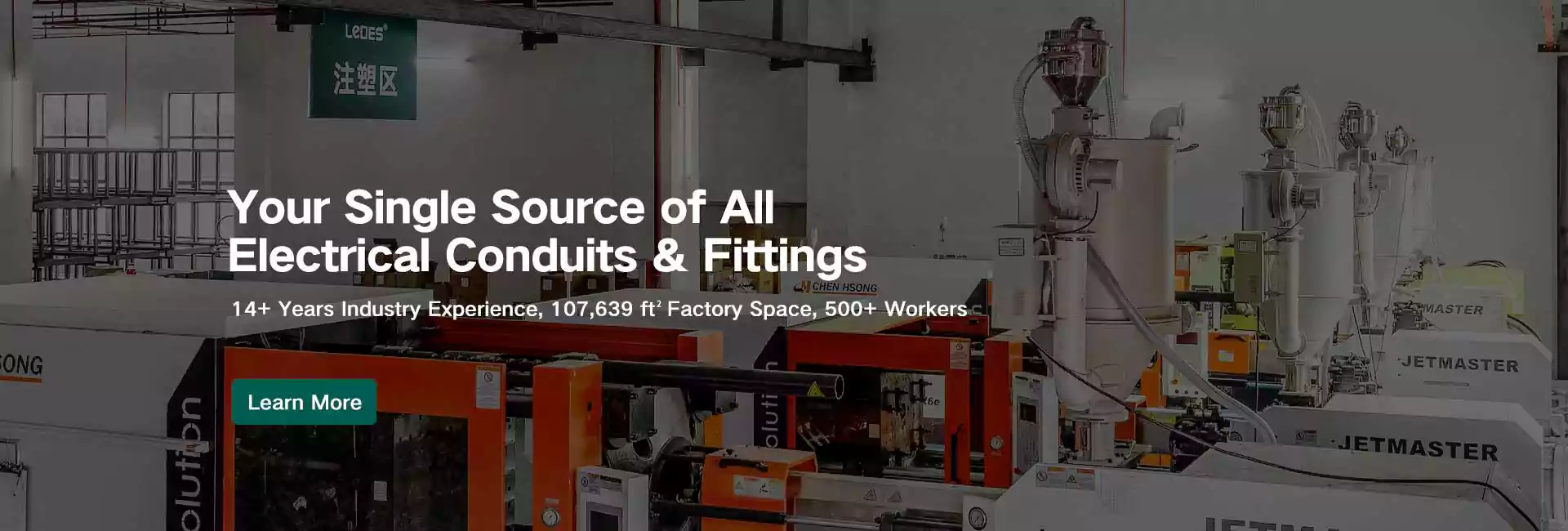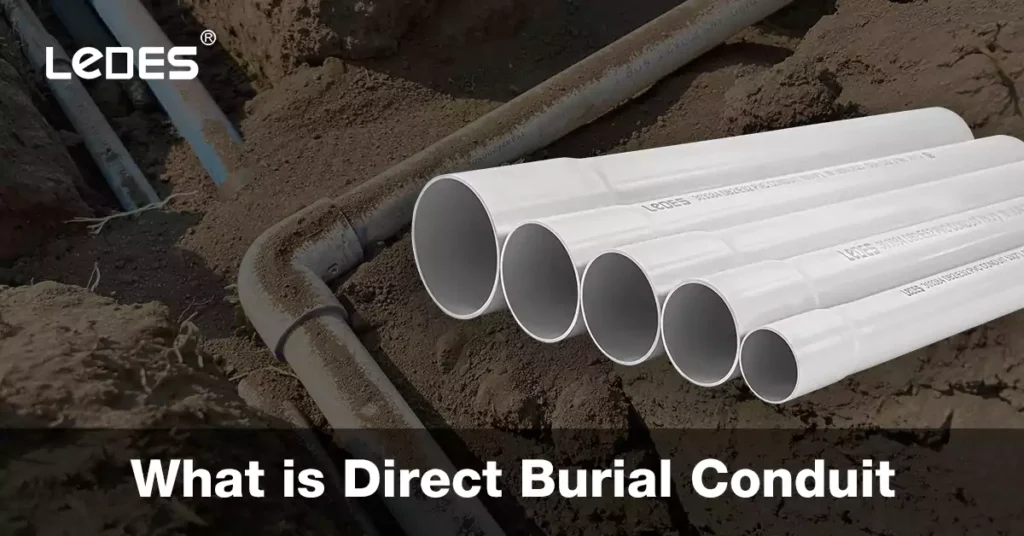
جدول المحتويات
Direct burial conduit refers to a type of piping or conduit system that is designed and installed underground without the need for additional protection or encasement. It is commonly used for electrical, telecommunications, or data communication applications where cables or wires need to be routed underground.
عادة ما تكون قناة الدفن المباشر مصنوعة من مواد متينة مثل البولي إيثيلين عالي الكثافة (HDPE) أو PVC الصلب (كلوريد البولي فينيل)، والتي توفر الحماية ضد الرطوبة وحموضة التربة والعوامل البيئية الأخرى. تم تصميم القناة لمقاومة التآكل والصدمات والسحق، مما يضمن سلامة الكابلات أو الأسلاك التي تحتوي عليها.
The “DB” in the name stands for “direct burial,” indicating its suitability for installation underground without requiring additional concrete encasement. This makes it a cost-effective and versatile option for various underground electrical applications.
There are several types of DB conduit available, each with its own specifications and advantages. Here are some of the most common used underground conduits in America and Canada.
Notes: Learn more about the details of the UL 651 standard requirement for PVC conduit in our last post if you are interested in this section.
DB60 conduit is a type of conduit specifically engineered to accommodate cables and wires in telecommunications and data networking applications. The “DB60” designation refers to its dimensions, with a standard size of 60mm in both height and width. However, it’s important to note that other sizes and variations may be available to suit specific installation requirements.
- Effortless Installation: Say goodbye to heavy concrete encasement. DB60’s direct burial capability saves you time and money, making installation a breeze.
- Superior Strength: DB60 is built to handle the pressure of underground soil and the stresses of movement, ensuring your cables stay secure.
- Cost-Effective Choice: Compared to traditional metal conduits, DB60 offers significant cost savings thanks to its ease of installation and lighter weight.
general guideline for minimum burial depths based on conduit type and location (refer to the National Electrical Code (NEC) and other industry standards for specific requirements):
- Residential areas: 18 inches(45cm)
- Commercial and industrial areas: 24 inches(60cm)
- Road crossings: 36 inches(90cm)
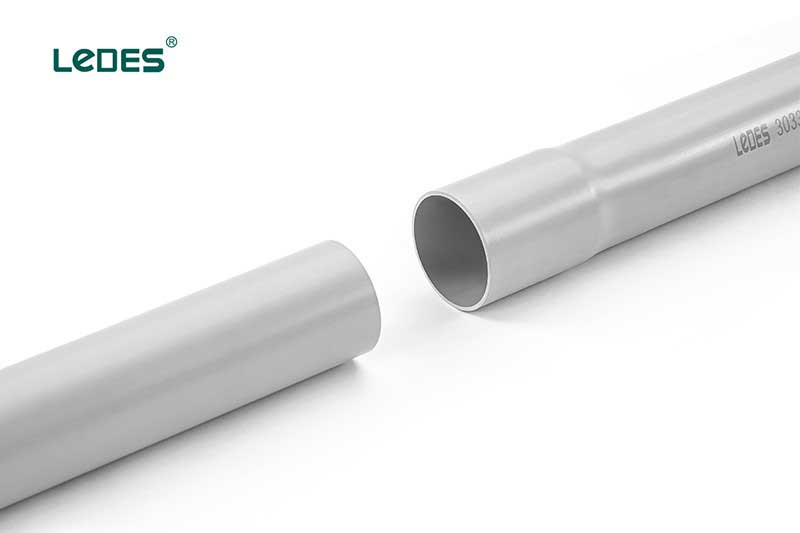
DB100 conduit is a type of PVC (polyvinyl chloride) conduit specifically designed for direct burial. It’s mainly used to protect electrical cables underground without needing extra encasement like concrete. DB100 is a lighter-duty conduit compared to heavier options like DB120, and it’s commonly used for residential, light commercial, and communication cable applications.
فعاله من حيث التكلفه:
DB100 is more affordable than heavier-rated conduits like DB120, making it a practical choice for projects that don’t require extreme mechanical strength.
خفيفة الوزن وسهلة التركيب:
Its thinner wall and lighter weight make DB100 easier to handle and faster to install, helping reduce labor time and costs.
Direct Burial Ready:
It’s manufactured specifically for underground installation without additional protection, simplifying trenching and cable laying.
Corrosion and Moisture Resistant:
Being PVC, DB100 doesn’t corrode like metal conduits and provides excellent resistance to moisture and many chemicals found in soil.
الداخلية السلسة:
The smooth inner surface reduces friction during cable pulling, helping prevent cable damage during installation.
While specific requirements can vary depending on local codes and project conditions, a common guideline is 18 to 24 inches (45–60 cm) from the top of the conduit to the ground surface for low-voltage and communication lines.
If installed under driveways, roadways, or where heavy equipment may cross, deeper burial (often 24 to 36 inches, sometimes with additional protection like concrete encasement) might be required.
DB120 conduit is a type of electrical conduit that is widely used for protecting and organizing electrical wires and cables. It is made from high-quality, durable materials such as polyvinyl chloride (PVC) or polyethylene (PE), which provide excellent resistance against corrosion, moisture, chemicals, and UV rays. The “DB120” designation refers to the specific schedule rating of the PVC, which indicates its wall thickness and strength.
- Durability: DB120 conduit is resistant to corrosion, chemicals, and weathering, making it ideal for long-term underground use.
- Impact resistance: The thick walls of DB120 conduit can withstand significant impact, protecting the wires inside from damage.
- Lightweight: Compared to concrete or metal conduit, DB120 is much lighter, making it easier to handle and install.
- Flexibility: DB120 conduit is available in a variety of lengths and diameters, making it easy to adapt to different project needs.
- Cost-effective: DB120 conduit is a relatively affordable option compared to other types of underground conduit.
- Residential areas: 12 inches (30 cm)
- Commercial and industrial areas: 18 inches (45 cm)
- Road crossings: 36 inches (90 cm)
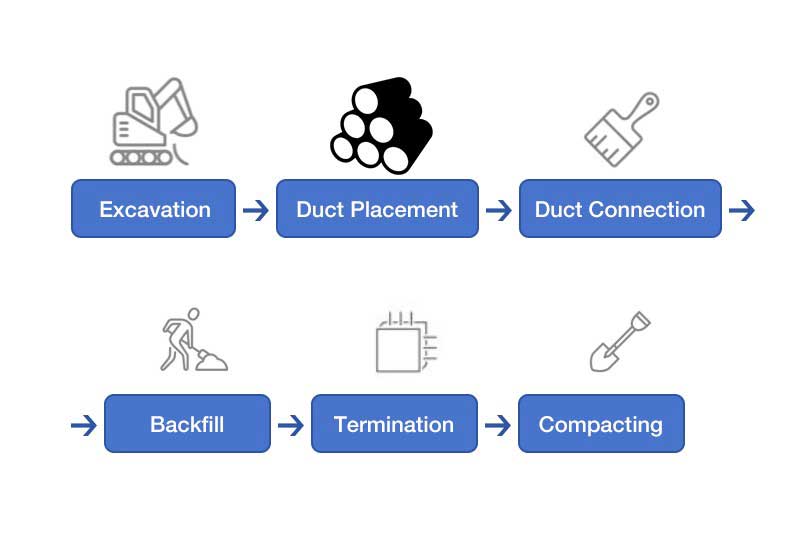
Installing DB120 conduit is a relatively straightforward process. Here are the basic steps:
- Excavate a trench: The trench should be deep enough to meet the local burial depth requirements for electrical and communication lines.
- Lay the conduit: Place the conduit in the trench, ensuring it is level and free of debris.
- Join the conduit sections: Use solvent cement or mechanical couplings to join the conduit sections together.
- Pull the wires: Pull the electrical or communication wires through the conduit.
- Backfill the trench: Backfill the trench with earth, tamping it down to eliminate air pockets.
DB120 conduit is used in a wide variety of applications, including:
- Residential and commercial underground electrical wiring
- Traffic signal and street lighting systems
- Telecommunication and data cables
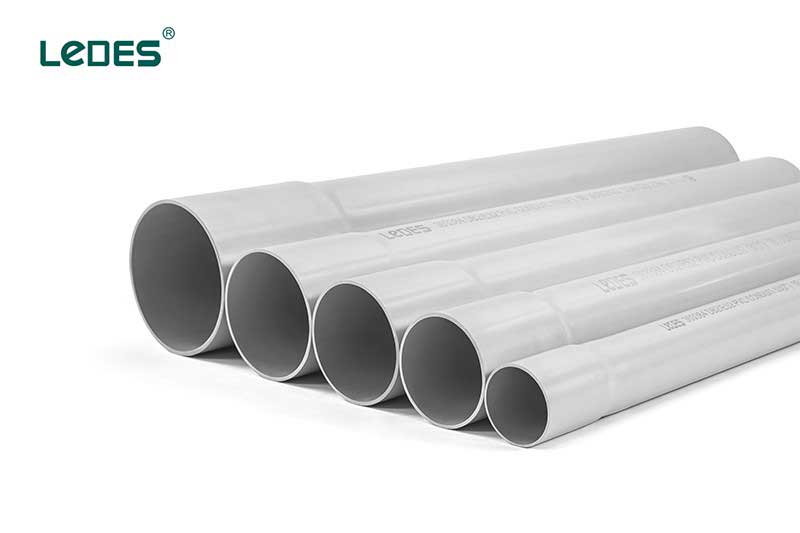
Crafted from sturdy PVC (polyvinyl chloride), these conduits are specifically designed for burial encased in concrete. This means they become an integral part of the underground infrastructure, shielding sensitive electrical cables from the harsh realities of buried life.
- Exceptional Strength: The “EB” designation signifies their exceptional impact resistance, able to withstand the pressures of shifting soil and accidental impacts. Think of them as silent guardians, keeping your electrical currents flowing uninterrupted.
- Superior Durability: Encased in concrete, these conduits form a robust and stable network, minimizing the risk of damage from ground movement and ensuring long-lasting performance.
- Lightweight: Compared to their metal counterparts, EB20/35 conduits are featherweights, making them easier to handle and install, saving time and labor costs.
- Compatibility: Available in a range of diameters and lengths, these conduits can be tailored to diverse project needs, from small residential installations to sprawling commercial complexes.
Installing EB20/35 conduit follows a straightforward process:
- Trench Warfare: Dig a trench deep enough to meet local burial depth requirements, providing ample protection for the electrical arteries within.
- Concrete Cradle: Prepare a bed of sturdy concrete to serve as a supportive and protective encasement for the conduit.
- Laying the Foundation: Carefully place the conduit sections in the trench, ensuring proper alignment and connection.
- Joining Forces: Use solvent cement or mechanical couplings to create a seamless and leak-proof conduit network.
- Concrete Cloak: Cover the conduit with the prepared concrete, creating a unified and impenetrable shield.
DB2/ES2 conduit refers to a specific type of duct used for communication purposes. It is typically a nonmetallic duct designed to house and protect communication cables, such as fiber optic cables or Ethernet cables. Ledes DB2 duct is made of PVC, certifed by CSA C22.2 No.211.1, and is commonly used in various industries, including telecommunications, networking, and data centers, to provide a conduit for the efficient and organized installation of communication cables.
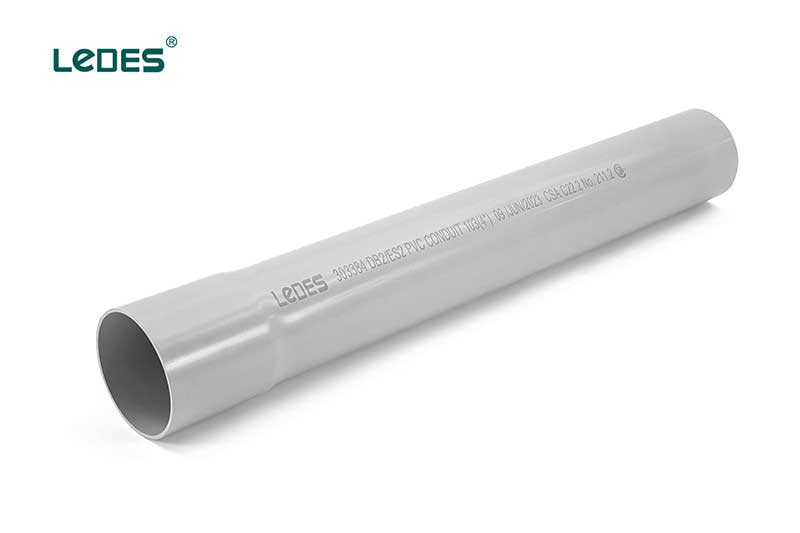
- Corrosion resistant: DB2/ES2 PVC duct made of high PVC material, its non-metallic, even exposed to naturally corrosive conditions, it won’t rust. Ensuring long-term performance in the underground world, providing safe and reliable protection for wiring systems.
- Lightweight: Its lightweight, making handling and installation easier and greatly saving time and labor costs.
- Direct burial: Its for direct burial applications and requires no additional protection when installed according to the Canadian Electrical Code(CEC).
- Easy wire pulls: DB2/ES2 has smooth interior surface reduces friction when pulling wires and cables through long runs.
DB2/ES2 PVC duct can be cut easily with a hacksaw, or use a PVC cutter for small sizes.
To join the lengths of duct or fittings, solvent cement is all that needed. PVC Solvent cement can make the joints strong and leak-proof. Easy handling and saving time.
- Trench Bottom: Dig a trench deep enough to meet local burial depth requirements, protecting the electrical lines within.
- Laying the Foundation: Carefully place DB2 duct sections in the trench, ensuring proper alignment and connection using solvent cement or mechanical couplings.
- Backfill: Once the conduit is secure, backfill the trench with earth, ensuring proper compaction to eliminate air pockets.
يمكن أن يختلف العمق الذي يجب دفن قناة DB فيه وفقًا لعوامل مختلفة، بما في ذلك اللوائح المحلية ومتطلبات المشروع المحددة ونوع التثبيت. ومع ذلك، هناك بعض الإرشادات العامة التي يجب مراعاتها:
اللوائح المحلية: تحقق من قوانين ولوائح البناء المحلية في منطقتك. غالبًا ما تحدد الحد الأدنى لعمق الدفن لأنواع مختلفة من القنوات والمرافق.
العوامل البيئية: ضع في اعتبارك عوامل مثل عمق الصقيع ونوع التربة وظروف الأرض. هذه العوامل يمكن أن تؤثر على استقرار القناة وحمايتها. في المناطق ذات درجات الحرارة المتجمدة، من الشائع دفن القنوات تحت خط الصقيع لمنع الضرر.
الحماية وإمكانية الوصول: يجب أن يتم دفن القناة على عمق يوفر الحماية الكافية من العناصر الخارجية، مثل الحفر وحركة المرور والعوامل البيئية. بالإضافة إلى ذلك، يجب دفنه على عمق يسمح بسهولة الصيانة والوصول إليه إذا لزم الأمر.
كمبدأ توجيهي عام، غالبًا ما يتم دفن قنوات الاتصال غير المعدنية مثل قنوات DB على عمق 1000 متر 18 إلى 24 بوصة (45 إلى 60 سم). ومع ذلك، فمن الضروري استشارة السلطات المحلية والمهنيين المطلعين على المشروع المحدد واللوائح المحلية لتحديد عمق الدفن المناسب لقناة DB في موقعك المحدد.
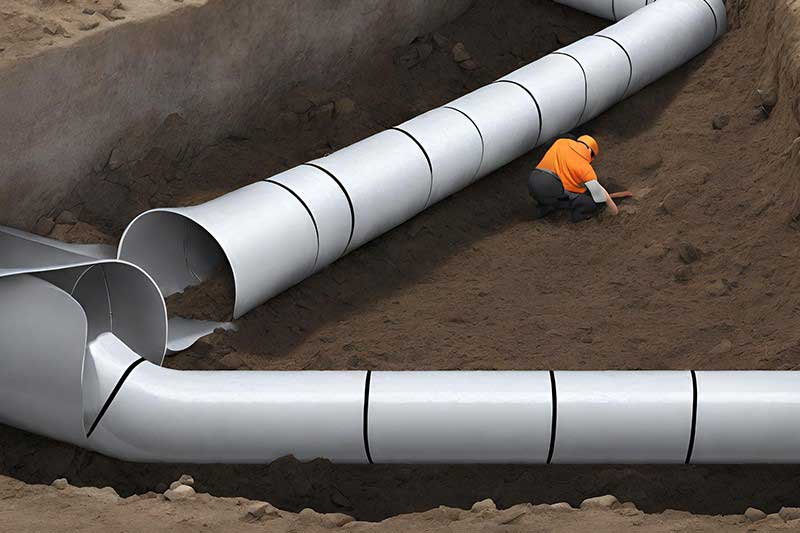
Before selecting a DB conduit for an underground project, it’s essential to understand the standards that govern its design, material, and performance. Standards ensure that conduits meet minimum safety, durability, and quality benchmarks – critical when infrastructure reliability is on the line.
In the United States, the main standards are:
- ASTM F512-19: Standard Specification for Smooth-Wall Poly(Vinyl Chloride) (PVC) Conduit and Fittings for Underground Installation.
- NEMA TC 6 & 8: Polyvinyl Chloride (PVC) Plastic Utilities Duct for Underground Installers.
In Canada, the key standard is:
- CSA C22.2 No. 211.1: Rigid types EB1 and DB2/ES2 PVC conduit.
Pro Tips: Want to learn more about the details of the CSA CC22.2 standard? Click the link to read our last post.
One of the most important standards for underground electrical conduit in the United States is ASTM F512-19. This specification defines the material, construction, and performance requirements for smooth-wall poly(vinyl chloride) (PVC) conduits and fittings used for underground installation of communication and electrical power cables.
The standard organizes conduits into five types, based on their stiffness and intended use:
Type EB-20 — Concrete encasement (lower stiffness)
Type EB-35 — Concrete encasement (higher stiffness)
Type DB-60 — Direct burial (lower stiffness)
Type DB-100 — Direct burial (higher stiffness)
Type DB-120 — Direct burial (very high stiffness)
EB types are mainly intended for installation within concrete encasement, while DB types are specifically built for burial directly in the soil, where higher strength and durability are essential.
To comply with ASTM F512-19, conduits must pass several critical tests that assess their durability and performance under underground conditions:
Conduits must be made from virgin or reworked PVC compound that meets detailed material properties such as strength, impact resistance, and chemical resistance.
The PVC material must meet specific cell classifications as defined in ASTM D1784, including:
- 12254
- 12164 (requiring a minimum tensile strength of 4000 psi or 28 MPa)
- 12264 (requiring a minimum tensile modulus of 500,000 psi)
Molded fittings must be made from PVC compounds with cell classifications of:
- 12234, or
- 13343,
also as defined under ASTM D1784.

Outside diameters, wall thicknesses, and lengths must fall within tight tolerances to ensure consistent quality and compatibility with fittings.
Special dimensional requirements are defined separately for EB and DB types due to their different burial conditions.
Pipe stiffness is a critical performance characteristic for underground conduits, particularly those intended for direct burial where soil loads and external pressures are a concern.
According to ASTM F512-19:
Minimum Pipe Stiffness Values are as follow:
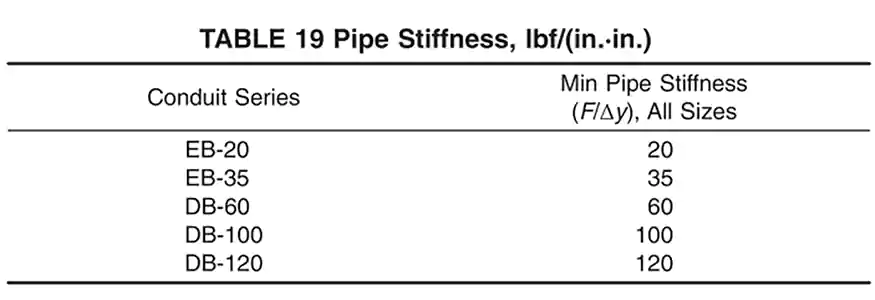
طريقة اختبار
The stiffness of the conduit is determined by a standardized parallel-plate loading test, following the procedures outlined in ASTM D2412. Here’s how the method works:
- A short length of pipe is placed horizontally between two rigid, parallel flat plates.
- The plates are brought together at a controlled rate of 0.50 ± 0.02 inches (12.5 ± 0.5 mm) per minute.
• During loading, load versus deflection (diameter change) data are recorded. - If cracking, crazing, delamination, or rupture occurs during the test, the corresponding load and deflection at the moment of failure are documented.
Impact resistance is another critical performance factor for underground PVC conduits. This is a quality control test that must be conducted at the time of manufacture to ensure consistent product reliability.
According to ASTM F512-19:
Minimum Requirements:
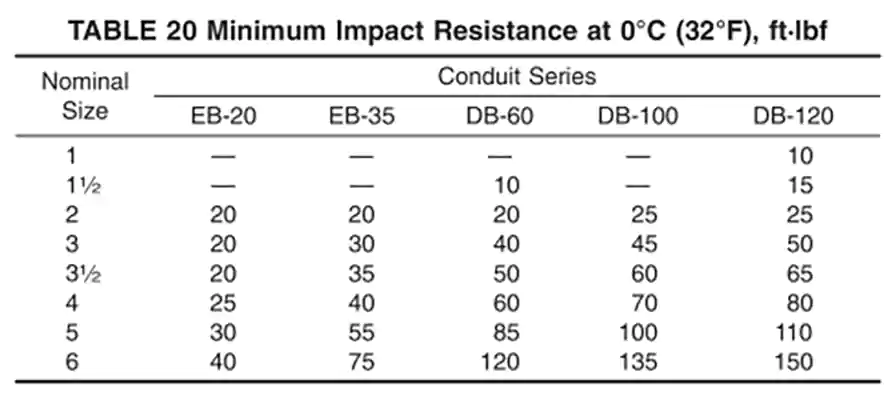
طريقة اختبار:
Impact testing is performed according to ASTM D2444, a 20-lb (9.1 kg) Tup B and a flat plate holder (Holder B) are used to apply the impact force.
اعتبارات درجة الحرارة:
If the test is performed at temperatures above 0°C (32°F), the specimen must be tested within 15 seconds after removal from the conditioning environment to maintain accuracy.
This impact test ensures that DB conduits can resist sudden, heavy loads without cracking or breaking, maintaining their structural integrity underground.
Ensuring a watertight connection between conduit sections is essential for underground installations, especially to prevent infiltration of moisture or soil into the electrical or communication pathways.
According to ASTM F512-19:
متطلبات:
Conduit joints must not leak when subjected to pressure testing.
طريقة اختبار:
- A section of conduit is cemented to a bell (socket) following the manufacturer’s instructions, or, if no instructions are available, by using the method described in ASTM Practice D2855.
- The assembled joint must stand undisturbed for at least 6 hours to allow the solvent cement to properly cure.
- After curing, the joint is subjected to an internal water pressure of at least 25 psi (170 kPa) and maintained at this pressure for at least 1 hour.
Passing Criteria:
During the test, no leakage of water is permitted.
Bond:
A probe or point of a knife blade is used to separate the concentric layers.
It shall not be possible to separate any two layers using a probe or the point of a knife blade in such a way that the layers come apart cleanly or that the probe or blade can move freely between them.
ASTM F512-19 requires conduit products to carry clear and standardized markings to ensure easy identification, traceability, and compliance with quality expectations. Key requirements include:
Manufacturer’s Name or Trademark
PVC Cell Classification
Nominal Size and Type of Conduit
Minimum Wall Thickness
Control or Code Number
Standard Designation must be marked:
“ASTM F512” for single extrusion conduit
“ASTM F512 COEX” for coextruded conduit
Marking Frequency: At intervals not exceeding 5 feet (1.5 meters) along the conduit length.
Additional markings are allowed if the manufacturer deems them useful.
In addition to ASTM standards, another important reference for underground PVC conduit manufacturing in North America is the NEMA TC 6 & 8 standard.
This standard is published by the National Electrical Manufacturers Association (NEMA) and plays a critical role in defining the performance and quality requirements for polyvinyl chloride (PVC) conduit used in both direct burial and concrete encasement applications.
Key Points and Testing Requirements:
Conduits and fittings must be made from high-quality PVC compounds that meet minimum performance standards for strength, chemical resistance, and durability. Similar as ASTM F512-19 requirements.
Precise tolerances are set for conduit diameter, wall thickness, and socket dimensions to ensure proper fit and function in the field.

Testing procedure and requirements are the same referenced in ASTM F512-19. Measurements are take at 5% vertical deflection of the conduit’s inside diameter.

The testing method and requirements are the same with ASTM F512-19, but NAME TC 6&8 explicitly warns that UV exposure reduces impact resistance; values only valid at time of manufacture.
Same requirements as ASTM F512-19.
Manufacturer’s Name or Trademark
Standard Size Designation and Type of Conduit
PVC Cell Classification
Standard designation
Marking Frequency: Markings must be repeated at uniform intervals and appear at least every 10 feet (3.05 meters).
Additional markings that manufacturer considers necessary.
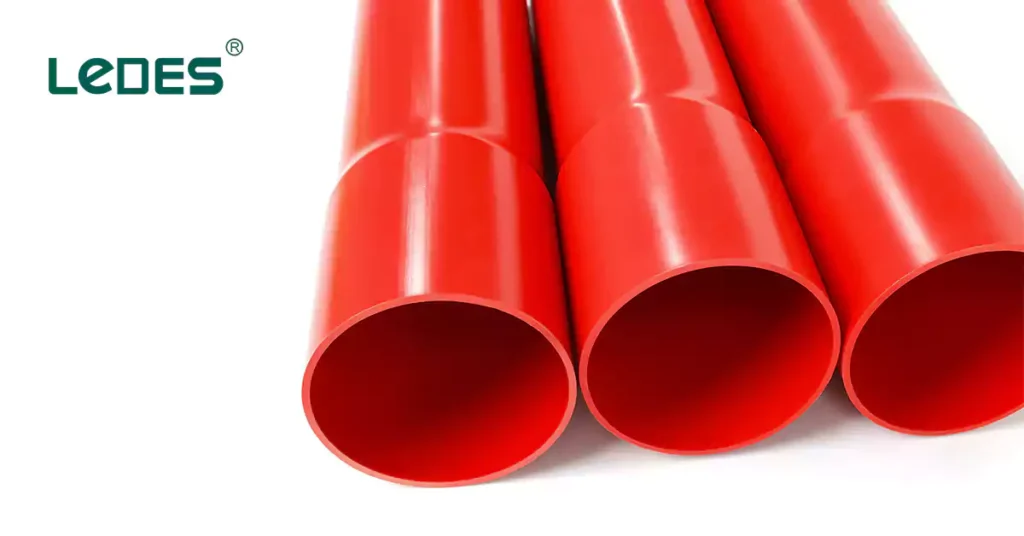
In addition to ASTM and NEMA standards, CSA C22.2 No. 211.1 is an important specification covering polyvinyl chloride (PVC) conduit intended for underground installations in Canada. CSA (Canadian Standards Association) standards ensure products meet strict safety and performance requirements suitable for Canadian environments, including extreme cold.
This standard sets the materials, construction and performance requirements for:
- أنابيب PVC الصلبة:
Type EB1: Intended for encasement in concrete or masonry.
Type DB2/ES2: Intended for direct burial in the ground or encasement in concrete or masonry.
- Associated Fittings:
Including straight couplings, 5° angle couplings, caps, plugs, bell-end terminators, bends, and adapters.
The conduit must be manufactured from PVC compounds that meet minimum requirements for physical and chemical properties such as tensile strength, impact resistance, and resistance to sunlight (for exposed sections). And have an ASTM D1784 cell classification of 12224.
The standards specifies the minimum wall thickness and outside diameters for different trade sizes. The requirements are different to ASTM and NEMA standards since they are different types and used in different regions.
This test verifies the toughness of the conduit material – especially under handling and installation conditions at both normal and cold temperatures.
طريقة اختبار:
A falling weight impacts the conduit placed on a specially prepared support bed.
Impact Energy and Temperatures
- At room temperature (23 °C): The impact energy applied must be 61 joules.
- At cold temperature (–18 °C): The impact energy applied must be 34 joules.
The crush resistance test evaluates the ability of PVC conduit to maintain its shape under compressive loading. This test ensures that the conduit can withstand burial or encasement pressures without permanent deformation.
إجراء الاختبار:
- Test is performed at 23 ± 2°C (standard room temperature).
- Before loading, the vertical inside diameter of each specimen is measured and recorded.
- Each specimen is placed horizontally between two flat steel platens on a static load test bed (according to Figure 2 of CSA C22.2 No. 211.0).
The conduit is positioned so that the vertical axis (direction of measurement) is under compression. - A test mass of 90 kg, including the mass of the upper platen, is applied gradually onto the specimen. The load is maintained for 60 ± 5 seconds.
- After 60 seconds under load, remeasure the vertical inside diameter. And after 300 ± 20 seconds (5 minutes), measure the vertical inside diameter again to assess recovery.
معايير النجاح:
- During Load:
The average percentage decrease in vertical diameter shall not exceed:
12% for Type EB1 conduit
10% for Type DB2/ES2 conduit
- After Recovery:
The average percentage decrease shall not exceed 5% for both types.
The test method is same as ASTM and NEMA standards, which is performed in accordance with ASTM D2412.
متطلبات:
- Type EB1 conduit must have a minimum pipe stiffness of 200 kPa at 5% deflection.
- Type DB2/ES2 conduit must have a minimum pipe stiffness of 300 kPa at 5% deflection.
إجراء الاختبار:
- Two pieces of conduit, each 1 ± 0.1 meters long, are solvent-cemented into a standard coupling.
- After assembly, the joint must be cured for 24 hours at room temperature to ensure proper bonding.
- The entire assembly is completely filled with water, ensuring no trapped air inside.
- A gauge pressure of 35 kPa (around 5 psi) is applied inside the filled assembly.
- The pressure must be maintained continuously for 4 hours.
معايير القبول:
- Throughout the 4-hour period, the joint must withstand the pressure without any rupture or leakage.
- Visual inspection is performed after the test to ensure no signs of leaking or joint separation.
Bond Strength:
- Choose eight points spaced equally around the circumference (every 45 degrees approximately).
- At each valley point, use a sharp probe or knife point. Attempt to separate the inner and outer walls manually by prying or picking.
- The conduit cannot cleanly separate the inner and outer walls at any of the eight points.
The chemical resistance requirements ensure that rigid PVC conduits maintain their mechanical and physical properties when exposed to aggressive chemical environments.
About Test:
The conduits are immersed for 7 days in the selected chemical solutions.
After immersion, the specimens must not exhibit a mass change greater then 2%.
After removing the samples from the chemical solutions, the specimens are subjected to a tensile strength at a crosshead speed of 12.7 mm/min ± 25% within 1 hour.
The average tensile strength of the chemical-exposed specimens must not differ from the average tensile strength of the control (unexposed) specimens by more than 15%.
Manufacturer’s name, trademark
Conduit type, such as DB2/ES2 PVC Conduit
Trade size
The date of manufacture
Standard: CSA C22.2 No.211.1
Item | ASTM F512-19 | نيما تي سي 6 و 8 | CSA C22.2 رقم 211.1 |
Region | U.S. | U.S. | كندا |
Conduit Types | EB20, EB35, DB60, DB100, DB120 | EB20, EB35, DB60, DB100, DB120 | EB1, DB2/ES2 |
مقاومة التأثير | 20 ft-lbf at 0 °C | 20 ft-lbf at 0 °C | 61 J at 23 °C, 34 J at -18 °C |
Crush Resistance | Not specified | Not specified | 90 kg load for 60s, avg. Deformation: EB1≤12%, DB2≤10%, recovery≤5% |
الكزازة | ASTM D2412: specify min. Stiffness for each conduit type at 5% deflection | Same as ASTM F512-19 | ASTM D2412: EB1≥200 kPa, DB2≥300 kPa at 5% deflection |
ضيق المفاصل | Water medium, 25 psi (172 kPa) pressure for 1 hour | Water medium, 25 psi (172 kPa) pressure for 1 hour | Water medium, 35 kPa (5 psi) pressure for 4 hours |
Bond Strength | No layer separation under probe or blade | Not specified | No clean separation allowed using knife at 8 points around circumference |
المقاومة الكيميائية | Not specified | Not specified | <2& mass change; tensile strength change <15% after 7-day immersion |
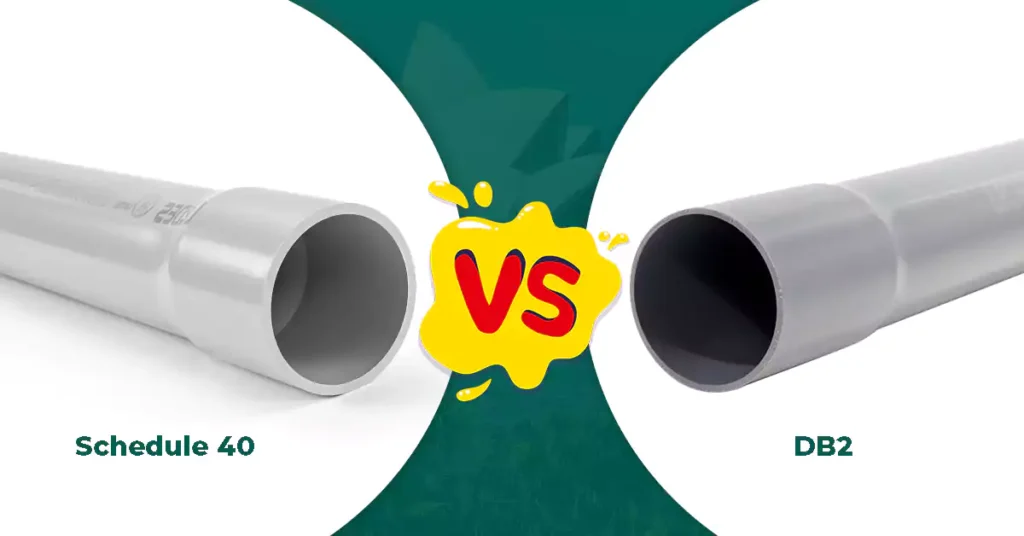
When selecting the right conduit for an electrical installation, one of the most important considerations is whether the conduit is intended for underground or above-ground applications. Two of the most common types are DB conduit (specifically DB2/ES2 for Canada or DB120 in the U.S.) and Schedule 40 PVC conduit.
While both are made from polyvinyl chloride (PVC), their designs, wall thicknesses, performance characteristics, and application scenarios differ significantly.
ميزة | DB Conduit (DB2/ES2, DB120) | جدول 40 أنابيب PVC |
الاستخدام الأساسي | Underground installations (direct burial or concrete encasement) | Above ground installations or embedded in walls/ floors |
Standard | CSA C22.2 No.211.1 (Canada), NEMA TC 6&8 (U.S.) | UL651, NEMA TC2 |
سمك الجدار | Thinner than Schedule 40 | Thicker wall for higher mechanical protection |
المرونة | More flexible for easier trench installation | More rigid |
Installation Method | Buried directly or encased in concrete | Surface-mounted or embedded in structures |
Crush Resistance | Designed for buried loads | Higher crush resistance due to thicker wall |
مقاومة الأشعة فوق البنفسجية | Not always UV resistant (buried) | Typically UV resistant for outdoor exposure |
Impact resistant | معتدل | Higher |
الكزازة | معتدل | Higher |
يكلف | More cost-effective | More expensive |
Understanding their differences can better help you to choose the right conduit type for your project, whether to choose DB conduit or above ground use conduit.

Choosing the right underground conduit starts with understanding your installation environment and matching it with the appropriate conduit type and standard. In the U.S., popular underground conduit types include EB20, EB35, DB60, DB100, DB120, Schedule 40, and Schedule 80. Each has specific strengths designed for different applications.
For concrete encased underground installations, choose the EB types.
For light-duty direct burial underground installations, such as garden lighting or residential landscape wiring, DB60 or DB100 can offer a budget-friendly solution with adequate protection. However, for most utility-grade and code-compliant electrical work, DB120 is considered the standard. It offers a balance of crush resistance, flexibility, and durability, making it suitable for use under driveways, sidewalks, or landscaped areas.
If your project requires conduits to run both underground and above ground (e.g., from underground into a building or panel), you may need to use to Schedule 40 or even Schedule 80 conduit. These rigid PVC conduits can used both underground and above-ground, and are thicker-walled, provide better UV resistance and impact protection when exposed. However, Schedule 40/80 are generally more rigid and may be harder to install in tight bends or curved runs, unlike DB conduit, which is easier to work with in trench applications.
Not all suppliers are created equal. Beyond just selling conduit, a dependable supplier should provide verified compliance with standards like CSA C22.2 No. 211.1, ASTM F512, or NEMA TC6 & 8. Look for evidence of product testing, such as impact resistance, joint tightness, stiffness, and bond integrity. Ask for certifications or test reports when necessary.
It’s also beneficial to work with a supplier that offers a complete system—conduits along with compatible fittings, adapters, elbows, and accessories—to ensure ease of assembly and reduce compatibility issues. Consider the supplier’s track record in your industry, their availability of technical support, and their responsiveness to project-specific needs. Local warehousing, fast delivery, and customization options are also key indicators of a reliable partner.
Ultimately, the best supplier is one that not only delivers high-quality products but also stands behind them with technical knowledge, compliance documentation, and after-sales support. Making the right choice will help your underground installation go smoothly and perform reliably for years to come.
When choosing between direct burial (DB) conduit and above-ground conduit systems, understanding the full cost-benefit profile is essential.
Upfront Cost: DB conduit typically has a lower initial cost than above-ground use conduit, such as Schedule 40 rigid PVC conduit
تكاليف التثبيت: DB conduit is easier to install due it’s lighter weight, making the labor costs lower. While Schedule 40 is heavier and potentially increases the installation costs.
Long – Term Costs: While DB conduit is less expensive upfront, it may require more frequent maintenance or replacements due to lower durability. Schedule 40, with its greater durability, can lead to lower long-term maintenance and replacement costs.
Direct Burial (DB) conduit plays a vital role in today’s underground electrical infrastructure, offering a reliable, durable, and code-compliant solution for protecting cables in harsh below-ground environments. Whether used in residential power distribution, commercial utilities, or infrastructure projects like EV charging stations and data centers, DB conduit stands out for its moisture resistance, long-term performance, and ability to meet stringent testing standards such as CSA C22.2 No. 211.1, ASTM F512, and NEMA TC6 & 8.
In this guide, we’ve explored the key differences between DB conduit and above-ground options like Schedule 40, breaking down everything from crush resistance and joint integrity to bond strength, chemical resistance, and cost-effectiveness. We’ve also discussed how to choose the right type of conduit and the importance of selecting a trustworthy supplier to ensure both compliance and performance.
Ultimately, DB conduit offers more than just buried protection – it delivers peace of mind. For those planning underground installations where safety, longevity, and minimal maintenance are priorities, DB conduit is a forward-thinking and cost-efficient choice.
signed for direct burial and concrete encasement, are the ideal choice for underground electrical installations. For more product information, please أرسل لنا نموذج الطلب أو مراسلتنا عبر البريد الإلكتروني مباشرة. سيساعدك فريق Ledes المحترف في الإجابة على أسئلتك واحتياجات مشاريعك.
Can I Use Direct Burial Cables Without a Conduit?
Yes, you can use direct burial cables without a conduit—but only if the cable is specifically rated for direct burial use. These cables are designed with robust insulation and jackets that can withstand underground conditions, including moisture, soil pressure, and temperature changes.
However, using conduit, especially DB type conduit, can provide extra mechanical protection for cables against rocks, shifting soil, and accidental digging.
What are the risks of sourcing direct burial products internationally?
Sourcing direct burial (DB) conduit products internationally can offer cost advantages, but it also comes with notable risks. Here are the key concerns:
- Product Quality
Not all direct burial conduits can meet the industry safety and performance requirements, when selecting the conduit manufacturer, make sure their products comply with the required standards and provide relevant test reports or certifications. If the conduit can’t meet the requirements, can result in costly failure and pose safety risks.
- Lead Time and Logistics
Shipping products from overseas can lead to longer lead times, especially in peak construction seasons. Unpredictable customs delays or disruptions due to geopolitical issues or port congestion. And need to pay increased freight costs.
نصائح: Plan procurement schedules in advance and ensure suppliers have reliable logistics partners. Always factor in buffer stock for urgent needs.
- Communication Barriers and After-Sales Support
Cross-time zone collaboration and language differences can lead to misinterpretations or delays in communication. Technical requirements may not be fully understood, and important issues might not be addressed in a timely manner. This can become especially problematic during installation or in the event of product failure, where quick access to technical support or replacement parts is critical. In some cases, after-sales service from international suppliers may be slow, unresponsive, or not aligned with local expectations.
نصائح: Choose suppliers with bilingual technical teams, clear communication channels, and a local or regional support network. Always confirm their responsiveness and support capabilities before committing to large-scale procurement.
Are there environmental considerations for direct burial installations?
Yes. Direct burial conduit systems must be designed with environmental factors in mind to ensure long-term reliability and safety. One of the primary concerns is soil composition—certain soils can be highly acidic or alkaline, which may degrade materials over time. In addition, microbial activity in the soil can contribute to corrosion, particularly in metallic components.
To mitigate these risks, conduits used for direct burial—such as PVC DB2 or HDPE conduit—are typically engineered to resist chemical attack and biological degradation. These materials are non-reactive, corrosion-resistant, and well-suited for harsh subsurface environments.
What certifications should I look for in direct burial products?
In the United States and Canada, products are expected to meet standards set by organizations like UL (Underwriters Laboratories), CSA (Canadian Standards Association), ASTM (American Society for Testing and Materials), and NEMA (National Electrical Manufacturers Association). These certifications confirm that the conduit has been rigorously tested for factors such as structural integrity, stiffness, chemical resistance, and joint tightness—qualities especially important in underground environments where long-term durability is critical.
For example, CSA C22.2 No. 211.1 covers direct burial PVC conduit in Canada, including DB2 and EB1 types, and mandates performance under various physical and chemical tests. Similarly, ASTM F512 addresses the requirements for coextruded pipe, such as uniform bond strength and resistance to layer separation. Products certified under UL standards may also carry additional marks for fire resistance or impact performance. Ensuring that your direct burial conduit carries these recognized certifications helps protect your installation from failure, reduces liability, and guarantees that you’re using a product suited for its intended underground application.
ما هي عيوب الكابلات الأرضية؟
في حين أن الكابلات تحت الأرض توفر العديد من المزايا، إلا أن هناك أيضًا بعض العيوب المرتبطة باستخدامها. فيما يلي بعض العيوب الشائعة للكابلات الأرضية:
- تكلفة التثبيت الأعلى: أحد العوائق الرئيسية للكابلات تحت الأرض هو ارتفاع تكلفة التركيب مقارنة بالكابلات العلوية. ويلزم إجراء أعمال الحفر وحفر الخنادق والمعدات المتخصصة لوضع الكابلات تحت الأرض. هذه النفقات الإضافية يمكن أن تجعل التثبيت الأولي أكثر تكلفة بكثير، خاصة في المناطق ذات السمات الجغرافية المعقدة أو البيئات الحضرية حيث توجد بالفعل بنية تحتية واسعة النطاق تحت الأرض.
- زيادة صعوبة الصيانة والإصلاح: تعد صيانة وإصلاح الكابلات الأرضية أكثر صعوبة وتستغرق وقتًا طويلاً مقارنة بالكابلات العلوية. يتطلب تحديد موقع الأعطال في الكابلات تحت الأرض معدات وخبرة متخصصة، وقد يكون الوصول إلى الكابلات المدفونة تحت الأرض أمرًا مرهقًا. يمكن أن تؤدي هذه الصعوبة في اكتشاف الأخطاء وإصلاحها إلى فترات توقف أطول وتكاليف صيانة أعلى.
- إمكانية الوصول المحدودة: لا يمكن الوصول إلى الكابلات الأرضية لأغراض الصيانة والإصلاحات. في المناطق ذات الكثافة السكانية العالية أو البيئات الحضرية، قد يكون الوصول إلى الكابلات تحت الأرض أمرًا صعبًا بشكل خاص بسبب وجود المباني والطرق والبنية التحتية الأخرى. يمكن أن تؤدي إمكانية الوصول المحدودة هذه إلى تأخيرات وتعطيلات أثناء أعمال الصيانة والإصلاح، مما يؤدي إلى زيادة التكاليف والتسبب في إزعاج مقدمي الخدمات والعملاء.
ما هي مخاطر دفن الكابلات تحت الأرض بدون قناة؟
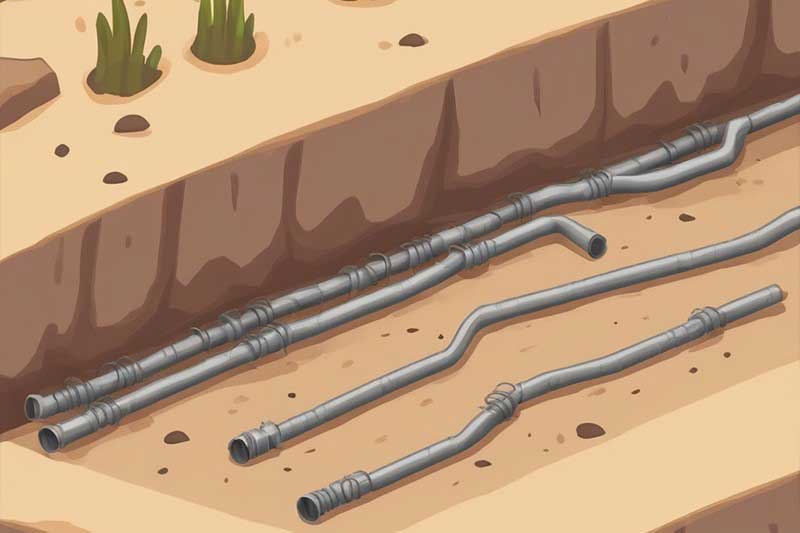
يمكن أن يشكل دفن الكابلات تحت الأرض بدون قناة العديد من المخاطر والعيوب. فيما يلي بعض المخاطر المحتملة المرتبطة بعدم استخدام القناة لتركيبات الكابلات تحت الأرض:
- الأضرار المادية: بدون حماية القناة، تكون الكابلات تحت الأرض أكثر عرضة للأضرار المادية الناجمة عن العوامل الخارجية مثل الصخور أو جذور الأشجار أو أنشطة البناء أو الحفر العرضي. بدون حاجز وقائي، تكون الكابلات أكثر تعرضًا وعرضة للتأثيرات أو الضغط المحتمل، مما قد يؤدي إلى تلف عزل الكابل أو كسر الموصل.
- دخول الرطوبة والماء: يمكن أن تكون البيئات تحت الأرض عرضة للرطوبة وتسلل المياه. بدون قناة، يكون هناك خطر أكبر لتسرب الماء إلى نظام الكابلات، مما قد يؤدي إلى تدهور العزل، ودوائر قصيرة، وتآكل الموصلات أو الموصلات. يمكن أن يؤثر دخول الرطوبة بشكل كبير على أداء الكابلات وطول عمرها، مما يؤدي إلى انقطاع الخدمة والإصلاحات المكلفة.
- التعرض للمواد الكيميائية: قد تحتوي المواقع تحت الأرض على مواد كيميائية أو مواد يمكن أن تؤثر سلبًا على سلامة الكابل وأدائه. وبدون قناة، تكون الكابلات أكثر عرضة للتعرض الكيميائي المحتمل من ملوثات التربة، أو الأنشطة الصناعية، أو الانسكابات العرضية. يمكن أن تؤدي التفاعلات الكيميائية إلى تدهور الكابلات وانهيار العزل وفشل النظام بشكل عام.
- صعوبة استبدال الكابل أو ترقيته: بدون قناة، يصبح استبدال أو ترقية الكابلات تحت الأرض أكثر صعوبة. قد يؤدي عدم وجود مسار مخصص إلى صعوبة إزالة وتركيب كابلات جديدة أو إجراء تعديلات على البنية التحتية الحالية. يمكن أن يؤدي هذا القيد إلى زيادة التعقيد والوقت والتكلفة المرتبطة باستبدال الكابلات أو ترقيات النظام في المستقبل.
- عدم وجود تعريف الكابل وتنظيمه: توفر القناة مسارًا منظمًا ومنظمًا للكابلات، مما يسمح بتحديدها وإدارتها بشكل أسهل. بدون القناة، قد تصبح الكابلات متشابكة أو غير منظمة، مما يجعل من الصعب تحديد موقع كابلات معينة للصيانة أو الإصلاحات أو التوسعات. يمكن أن يؤدي هذا إلى زيادة وقت التوقف عن العمل وعدم الكفاءة أثناء استكشاف الأخطاء وإصلاحها أو ترقية النظام.
هل يحتاج كابل الدفن المباشر إلى قناة؟
لا تتطلب كابلات الدفن المباشرة قناة للتركيب. وهي مصممة خصيصًا ليتم دفنها مباشرة في الأرض دون حماية إضافية. تحتوي هذه الكابلات على عزل وسترات توفر مقاومة للرطوبة وتغيرات درجات الحرارة والأضرار المادية. ومع ذلك، قد يكون للقوانين واللوائح الكهربائية المحلية متطلبات محددة، لذلك من المهم الرجوع إليها.
في حين يمكن تركيب كابلات الدفن المباشر بدون قناة، فإن استخدام القناة قد يوفر فوائد إضافية اعتمادًا على المتطلبات المحددة للمشروع. يمكن أن توفر القناة حماية مادية إضافية وتجعل استبدال الكابل أو صيانته أسهل. يمكن أن يكون مفيدًا أيضًا في الظروف البيئية الصعبة أو لتحديد موقع الكابل. ومع ذلك، فإن تركيب القناة يزيد التكلفة والتعقيد للمشروع.
في النهاية، يعتمد قرار استخدام قناة مع كابلات الدفن المباشرة على عوامل مثل ظروف التربة، ومتطلبات المشروع، واللوائح المحلية. يمكن أن يساعد تقييم هذه الجوانب والتشاور مع كهربائي محترف في تحديد أفضل نهج يناسب ظروفك الخاصة.
ما هي القناة الأفضل للدفن المباشر؟
يوصى عادةً بأن تكون أفضل قناة للدفن المباشر هي PVC (البولي فينيل كلورايد) نظرًا لمتانتها وثباتها وأدائها المثبت. لقد تم استخدام واختبار قنوات PVC على نطاق واسع للتركيبات تحت الأرض. أنها توفر العديد من المزايا، بما في ذلك:
متانة: تُعرف قنوات PVC بقوتها وقدرتها على تحمل الضغوط والتأثيرات الخارجية. إنها توفر حماية موثوقة للكابلات ضد الأضرار المادية الناجمة عن الصخور أو تحرك التربة أو غيرها من المخاطر المحتملة.
مقاوم للرطوبة: يتميز PVC بمقاومته العالية للرطوبة ودخول الماء، مما يجعله خيارًا مثاليًا للتطبيقات تحت الأرض. فهو يساعد على منع وصول الماء إلى الكابلات، مما قد يتسبب في تدهور العزل أو حدوث دوائر قصيرة.
خيارات الحجم: تتوفر قنوات PVC بأحجام مختلفة، مما يسمح بالمرونة في استيعاب أقطار الكابلات المختلفة أو الكابلات المتعددة داخل قناة واحدة. هذا التنوع يجعل قنوات PVC مناسبة لمجموعة واسعة من تركيبات كابلات الدفن المباشر.
الفعالية من حيث التكلفة: تعتبر قنوات PVC بشكل عام أكثر فعالية من حيث التكلفة مقارنة بالخيارات الأخرى مثل القنوات المعدنية. فهي أقل تكلفة للشراء والتركيب، مما يساهم في توفير التكلفة الإجمالية للمشروع.
بالإضافة إلى ذلك، تعتبر قنوات البلاستيك المقوى بالألياف الزجاجية (FRP) خيارًا آخر لتطبيقات الدفن المباشر. توفر قنوات FRP متانة ممتازة، ومقاومة للتآكل، وقوة شد عالية. وهي معروفة بخصائصها غير الموصلة، مما يجعلها مناسبة للتركيبات التي يكون فيها التأريض الكهربائي مصدر قلق. تعتبر قنوات FRP مفيدة بشكل خاص في البيئات المسببة للتآكل أو المناطق ذات المحتوى العالي من الرطوبة.
هل قناة PVC مناسبة للدفن المباشر؟
وفقًا لرمز NEC 352.10 الاستخدامات المسموح بها، فإن قناة PVC مناسبة للدفن المباشر وتحت الأرض المغطاة بالخرسانة. وهذا يعني أن قناة PVC يمكن دفنها مباشرة في الأرض دون الحاجة إلى حماية إضافية، طالما أنها تتوافق مع المتطلبات المحددة في القسمين 300.5 و305.15 من NEC. توفر هذه الأقسام إرشادات لتركيب القنوات في التطبيقات تحت الأرض، بما في ذلك سيناريوهات الدفن المباشر. ولذلك، تعتبر قناة PVC خيارًا مناسبًا لتركيبات الدفن المباشر، وفقًا للوائح NEC.
ما هو العمق الذي يجب دفن الخطوط الكهربائية فيه؟
يمكن أن يختلف العمق الذي يجب دفن الخطوط الكهربائية فيه اعتمادًا على عدة عوامل، بما في ذلك نوع الخط الكهربائي وقوانين البناء المحلية واللوائح. وفيما يلي بعض الإرشادات العامة:
- خطوط الكهرباء السكنية: في معظم التطبيقات السكنية، يتم عادةً دفن الخطوط الكهربائية، مثل كابلات مدخل الخدمة أو مغذيات تحت الأرض، على عمق يتراوح من 18 إلى 24 بوصة (45 إلى 60 سم). ومع ذلك، قد تتطلب القوانين المحلية أعماقًا أعمق للدفن، لذلك من الضروري استشارة اللوائح المحددة في منطقتك.
- خطوط الكهرباء التجارية والصناعية: بالنسبة للمنشآت التجارية أو الصناعية، غالبًا ما يكون عمق دفن الخطوط الكهربائية أكبر منه في الأماكن السكنية. يمكن أن تتراوح الأعماق من 24 إلى 36 بوصة (60 إلى 90 سم) أو حتى أعمق، اعتمادًا على نوع الخط الكهربائي والجهد والأكواد المحلية.
- كابلات الدفن المباشر: كابلات الدفن المباشر، المصممة للتركيبات تحت الأرض بدون قناة، لها بشكل عام متطلبات عمق دفن محددة تحددها الشركة المصنعة. من الضروري اتباع إرشادات الشركة المصنعة لضمان التثبيت والأداء المناسبين للكابل.
- عوامل اخرى: إلى جانب عمق الدفن، من المهم مراعاة عوامل مثل نوع التربة والظروف البيئية ووجود المرافق الأخرى. قد تتطلب بعض القوانين المحلية متطلبات عمق أو خلوص إضافية لحماية الخطوط الكهربائية من التلف الناتج عن العوامل الخارجية أو الحفر المستقبلي.

